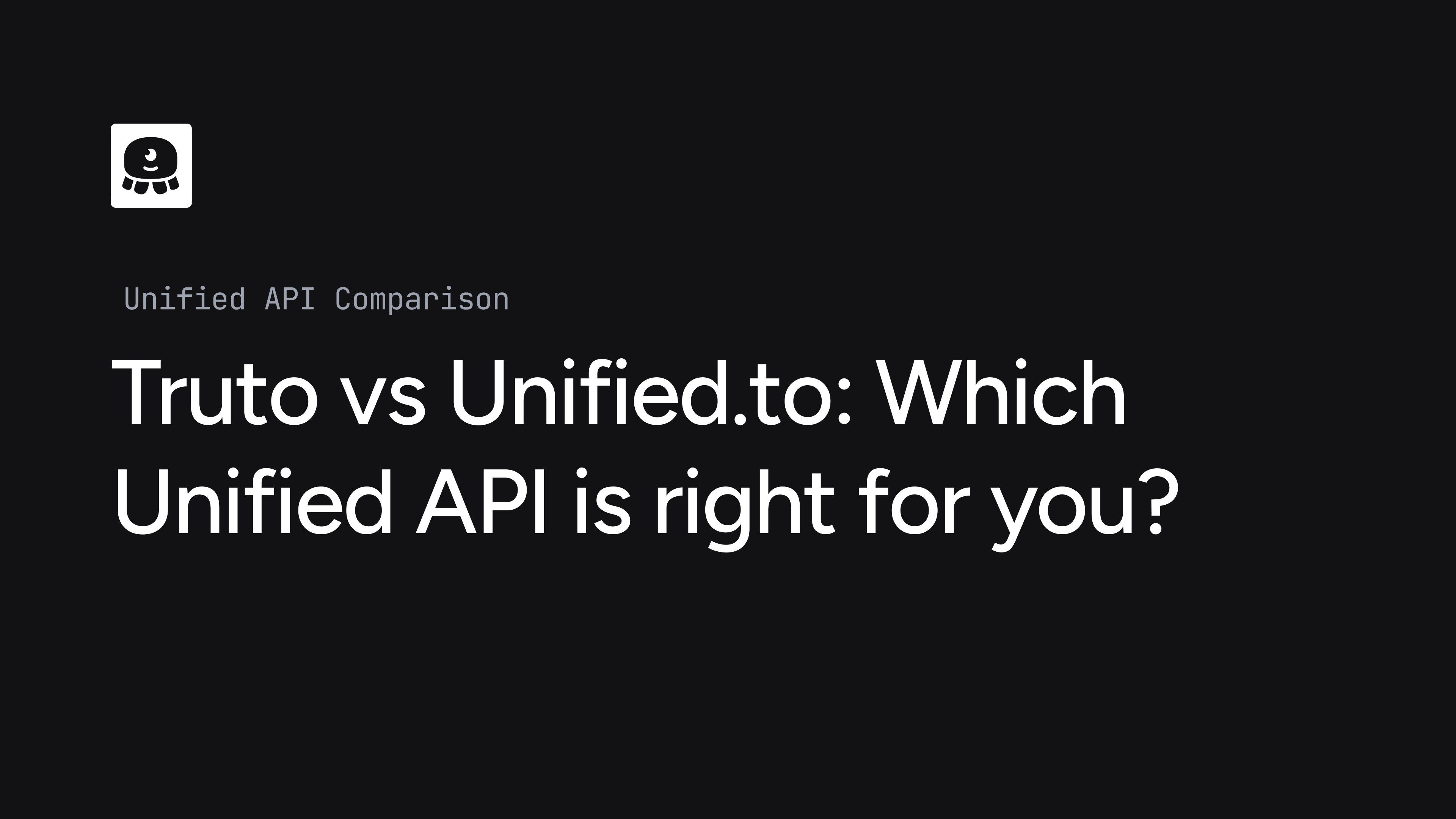Truto vs. Unified.to: which Unified API is best for AI pipelines and real-time data delivery?
May 23, 2025

Truto helps teams roll out integrations with custom schemas and sync jobs. But if you're building real-time pipelines, AI features, or normalized data infrastructure, you'll run into limitations fast.
Unified.to is built for modern SaaS: a unified API platform with real-time webhooks, deeply structured schemas, and zero data storage. You get normalized data from 270+ integrations—delivered in real time, streamed to your database, and always under your control.
At a glance: Unified.to vs Truto
Truto offers broad integration coverage with flexible schema customization. Unified.to focuses on fast, real-time infrastructure for developers building AI-ready SaaS.
Unified.to gives you:
- Real-time updates (native + virtual webhooks, no polling)
- 270+ integrations across 20 high-use categories
- Deeply normalized schemas with passthrough + custom fields
- Database sync: stream structured records to Postgres, Mongo, and more
- Zero-data architecture: no caching, no stored customer data
Real-time data without sync jobs or polling intervals
Truto offers a polling-based sync engine (RapidBridge) to keep customer data fresh, with sync intervals starting at 5 minutes.
Unified.to is real-time by default. It uses native and virtual webhooks to deliver structured updates instantly—no need to configure sync jobs, polling scripts, or background retries.
For teams building agents, dashboards, or event-driven features, latency matters. Unified.to keeps you in sync by default.
Clean, normalized data across 270+ APIs
Truto lets you define your own schemas and mappings, which is powerful but manual.
Unified.to gives you deeply normalized data models out of the box—one consistent schema per object, across all platforms. Whether you're working with ATS candidates, CRM contacts, or accounting invoices, you get standardized fields, enums, and relationships with no extra mapping work. Passthrough fields and custom overrides are available when needed.
Structured pipelines for AI, RAG, and analytics
Truto supports AI workflows like RAG pipelines via sync-to-database and selective data sync (RapidForm).
Unified.to goes further with Database Sync: it streams real-time records from 270+ APIs into your DB—no ETL required. Whether you're embedding data into a vector store, joining it with internal metrics, or serving it to an agent, Unified.to makes live, structured data a first-class output.
No data stored. No vendor lock-in.
Truto is SOC 2 and HIPAA compliant and doesn't cache third-party data. But Unified.to takes it further: no customer data is ever stored—logs, payloads, and tokens stay with you.
Store credentials in your own secrets manager. Stream logs into your own observability tools. When data security matters, zero-caching and full data ownership keeps your team in control.
Developer-first experience
Unified.to provides full SDK coverage (Python, TypeScript, Go, Ruby, PHP, and more), embedded Connect UI, and clean, declarative APIs.
Truto offers a visual builder to define unified schemas, with strong support for custom mappings and transformation logic.
But if your team prefers to integrate directly via code—without configuring every connector—Unified.to gives you fast starts, consistent models, and real-time observability out of the box.
TL;DR — Unified.to vs Truto
| Feature | Unified.to | Truto |
|---|---|---|
| Data model | Deeply normalized schemas with 1100+ objects | Configurable schemas, manually mapped |
| Real-time support | Native + virtual webhooks | Native webhooks + 5-min sync jobs |
| AI readiness | Real-time Database sync to your DB | Sync to DB with manual job config |
| Data storage | No caching, no persistence | No caching, but stores tokens/logs |
| Developer experience | SDKS, API-first, declarative | Builder UI, custom mapping tools |
| Onboarding | 30-day free trial, $350/mo to start | $499/mo minimum, custom plans for services |
| Best for | AI-native, real-time apps | High-volume integration delivery |
Unified.to gives you normalized data, real-time updates, and developer-friendly delivery options—without storage or sync job complexity.
Start your free 30-day trial or book a demo to see how fast you can go from integration request to production.
